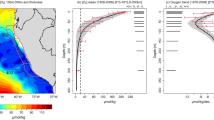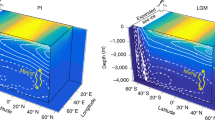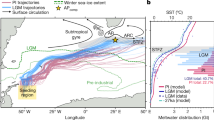Abstract
Global observations show that the ocean lost approximately 2% of its oxygen inventory over the past five decades1,2,3, with important implications for marine ecosystems4,5. The rate of change varies regionally, with northwest Atlantic coastal waters showing a long-term drop6,7 that vastly outpaces the global and North Atlantic basin mean deoxygenation rates5,8. However, past work has been unable to differentiate the role of large-scale climate forcing from that of local processes. Here, we use hydrographic evidence to show that a Labrador Current retreat is playing a key role in the deoxygenation on the northwest Atlantic shelf. A high-resolution global coupled climate–biogeochemistry model9 reproduces the observed decline of saturation oxygen concentrations in the region, driven by a retreat of the equatorward-flowing Labrador Current and an associated shift towards more oxygen-poor subtropical waters on the shelf. The dynamical changes underlying the shift in shelf water properties are correlated with a slowdown in the simulated Atlantic Meridional Overturning Circulation (AMOC)10. Our results provide strong evidence that a major, centennial-scale change of the Labrador Current is underway, and highlight the potential for ocean dynamics to impact coastal deoxygenation over the coming century.
This is a preview of subscription content, access via your institution
Access options
Access Nature and 54 other Nature Portfolio journals
Get Nature+, our best-value online-access subscription
$29.99 / 30 days
cancel any time
Subscribe to this journal
Receive 12 print issues and online access
$209.00 per year
only $17.42 per issue
Buy this article
- Purchase on Springer Link
- Instant access to full article PDF
Prices may be subject to local taxes which are calculated during checkout




Similar content being viewed by others
References
Helm, K. P., Bindoff, N. L., & Church, J. A. Observed decreases in oxygen content of the global ocean.Geophys. Res. Lett. 38, L23602 (2011).
Schmidtko, S., Stramma, L. & Visbeck, M. Decline in global oceanic oxygen content during the past five decades. Nature 542, 335–339 (2017).
Ito, T., Minobe, S., Long, M. C. & Deutsch, C. Upper ocean O2 trends: 1958–2015. Geophys. Res. Lett. 44, 4214–4223 (2017).
Breitburg, D. et al. Declining oxygen in the global ocean and coastal waters.Science 359, eaam7240 (2018).
Levin, L. A. Manifestation, drivers, and emergence of open ocean deoxygenation. Ann. Rev. Mar. Sci. 10, 229–260 (2018).
Petrie, B. & Yeats, P. Annual and interannual variability of nutrients and their estimated fluxes in the Scotian Shelf—Gulf of Maine region. Can. J. Fish. Aquat. Sci. 57, 2536–2546 (2000).
Gilbert, D., Sundby, B., Gobeil, C., Mucci, A. & Tremblay, G.-H. A seventy-two-year record of diminishing deep-water oxygen in the St. Lawrence estuary: the northwest Atlantic connection. Limnol. Oceanogr. 50, 1654–1666 (2005).
Gilbert, D., Rabalais, N. N., Díaz, R. J. & Zhang, J. Evidence for greater oxygen decline rates in the coastal ocean than in the open ocean. Biogeosciences 7, 2283–2296 (2010).
Dufour, C. O. et al. Role of mesoscale eddies in cross-frontal transport of heat and biogeochemical tracers in the Southern Ocean. J. Phys. Oceanogr. 45, 3057–3081 (2015).
Caesar, L., Rahmstorf, S., Robinson, A., Feulner, G. & Saba, V. Observed fingerprint of a weakening Atlantic Ocean overturning circulation. Nature 556, 191–196 (2018).
Keeling, R. F., Körtzinger, A. & Gruber, N. Ocean deoxygenation in a warming world. Ann. Rev. Mar. Sci. 2, 199–229 (2010).
Long, M. C., Deutsch, C. & Ito, T. Finding forced trends in oceanic oxygen. Glob. Biogeochem. Cycles 30, 381–397 (2016).
Johnson, G. C. & Gruber, N. Decadal water mass variations along 20° W in the Northeastern Atlantic Ocean. Prog. Oceanogr. 73, 277–295 (2007).
Frölicher, T. L., Joos, F., Plattner, G.-K., Steinacher, M. & Doney, S. C. Natural variability and anthropogenic trends in oceanic oxygen in a coupled carbon cycle-climate model ensemble. Glob. Biogeochem. Cycles 23, GB1003 (2009).
Stendardo, I. & Gruber, N. Oxygen trends over five decades in the North Atlantic.J. Geophys. Res. Oceans 117, C11004 (2012).
Brennan, C. E., Blanchard, H. & Fennel, K. Putting temperature and oxygen thresholds of marine animals in context of environmental change: a regional perspective for the Scotian Shelf and Gulf of St. Lawrence. PLoS ONE 11, 1–27 (2016).
Thibodeau, B., de Vernal, A., Hillaire-Marcel, C. & Mucci, A. Twentieth century warming in deep waters of the Gulf of St. Lawrence: A unique feature of the last millennium. Geophys. Res. Lett. 37, L17604 (2010).
Genovesi, L. et al. Recent changes in bottom water oxygenation and temperature in the Gulf of St. Lawrence: micropaleontological and geochemical evidence. Limnol. Oceanogr. 56, 1319–1329 (2011).
Keigwin, L., Sachs, J. & Rosenthal, Y. A 1600-year history of the Labrador Current off Nova Scotia. Clim. Dynam. 12, 53–62 (2003).
Sherwood, O. A., Lehmann, M. F., Schubert, C. J., Scott, D. B. & McCarthy, M. D. Nutrient regime shift in the western North Atlantic indicated by compound-specific δ15N of deep-sea gorgonian corals. Proc. Natl Acad. Sci. USA 108, 1011–1015 (2011).
Thornalley, D. J. R. et al. Anomalously weak Labrador Sea convection and Atlantic overturning during the past 150 years. Nature 556, 227–230 (2018).
Loder, J. W., van der Baaren, A. & Yashayaev, I. Climate comparisons and change projections for the Northwest Atlantic from six CMIP5 models. Atmos. Ocean 53, 529–555 (2015).
Saba, V. S. et al. Enhanced warming of the Northwest Atlantic Ocean under climate change. J. Geophys. Res. Oceans 121, 118–132 (2016).
Lavoie, D., Lambert, N. & Gilbert, D. Projections of future trends in biogeochemical conditions in the northwest Atlantic using CMIP5 Earth system models. Atmos. Ocean https://doi.org/10.1080/07055900.2017.1401973 (2017).
Joyce, T. M. & Zhang, R. On the path of the Gulf Stream and the Atlantic Meridional Overturning Circulation. J. Clim. 23, 3146–3154 (2010).
Buckley, M. W. & Marshall, J. Observations, inferences, and mechanisms of the Atlantic Meridional Overturning Circulation: a review. Rev. Geophys. 54, 5–63 (2016).
Petrie, B. & Drinkwater, K. Temperature and salinity variability on the Scotian Shelf and in the Gulf of Maine 1945–1990. J. Geophys. Res. Oceans 98, 20079–20089 (1993).
Peterson, I., Greenan, B., Gilbert, D. & Hebert, D. Variability and wind forcing of ocean temperature and thermal fronts in the Slope Water region of the Northwest Atlantic. J. Geophys. Res. Oceans 122, 7325–7343 (2017).
Bianucci, L., Fennel, K., Chabot, D., Shackell, N. & Lavoie, D. Ocean biogeochemical models as management tools: a case study for Atlantic wolffish and declining oxygen. ICES J. Mar. Sci. 73, 263–274 (2016).
Tagklis, F., Bracco, A. & Ito, T. Physically driven patchy O2 changes in the North Atlantic Ocean simulated by the CMIP5 Earth system models. Glob. Biogeochem. Cycles 31, 1218–1235 (2017).
Gatien, M. G. A study in the slope water region south of Halifax. J. Fish Res. Board Can. 33, 2213–2217 (1976).
Bisagni, J. J., Gangopadhyay, A. & Sanchez-Franks, A. Secular change and inter-annual variability of the Gulf Stream position, 1993–2013, 70°–55° W. Deep Sea Res. I 125, 1–10 (2017).
Warren, B. A. Nansen-bottle stations at the Woods Hole Oceanographic Institution. Deep Sea Res. I 55, 379–395 (2008).
Millero, F. J., Chen, C.-T., Bradshaw, A. & Schleicher, K. A new high pressure equation of state for seawater. Deep Sea Res. A 27, 255–264 (1980).
Galbraith, E. D. et al. Complex functionality with minimal computation: promise and pitfalls of reduced-tracer ocean biogeochemistry models. J. Adv. Model. Earth Syst. 7, 2012–2028 (2015).
Acknowledgements
The authors thank A. Cogswell and R. Pettipas from Fisheries and Oceans Canada for providing hydrographic data in the central Scotian Shelf and C. E. Brennan for providing the data for the oxygen time series in the central Scotian Shelf. The authors also acknowledge many scientists at NOAA GFDL that configured and ran the climate model, without whose efforts this work would not have been possible. This project has received funding from the European Research Council under the European Union’s Horizon 2020 research and innovation programme (grant no. 682602). E.D.G. acknowledges financial support from the Spanish Ministry of Economy and Competitiveness through the Mara de Maeztu Programme for Centres/Units of Excellence (MDM-2015-0552). The Canadian Foundation for Innovation provided the computing resources for model analysis. D.B. acknowledges support from NOAA grant NA15NOS4780186.
Author information
Authors and Affiliations
Contributions
E.D.G., J.B.P. and D.B. conceived the study. M.C., D.G. and K.F. assembled and analysed the observational data. M.C. and D.B. performed the model output analyses. J.P.D. and E.D.G. participated in the design of the CM2.6-miniBLING experiments. M.C., E.D.G., J.B.P. and D.B. wrote the first draft of the manuscript. All the authors discussed the results and provided input to the manuscript.
Corresponding author
Ethics declarations
Competing interests
The authors declare no competing Interests.
Additional information
Publisher’s note: Springer Nature remains neutral with regard to jurisdictional claims in published maps and institutional affiliations.
Supplementary information
Supplementary Information Description: Supplementary figures 1–9, Supplementary Notes, Supplementary References, Supplementary Tables 1–3
Supplementary figures 1–9, Supplementary Notes, Supplementary References, Supplementary Tables 1–3
Supplementary Video 1
Time evolution of simulated O2 in the northwest Atlantic on isopycnal σθ = 27.25 kg m−3 over the last twenty model years (from 181 to 200) for preindustrial control (LEFT) and warming (1% annual pCO2 increase until doubled, RIGHT) scenarios. Climate model horizontal resolution is 1/10° and the time period between movie frames is five days. The movie shows that the oxygen supply to slope waters (white shading in Fig. 1) and the Laurentian Channel decreases significantly under warming due to a reduction in transport of ventilated Labrador Current waters west of the Tail of the Grand Banks. Isopycnal outcrop is shown in white
Rights and permissions
About this article
Cite this article
Claret, M., Galbraith, E.D., Palter, J.B. et al. Rapid coastal deoxygenation due to ocean circulation shift in the northwest Atlantic. Nature Clim Change 8, 868–872 (2018). https://doi.org/10.1038/s41558-018-0263-1
Received:
Accepted:
Published:
Issue Date:
DOI: https://doi.org/10.1038/s41558-018-0263-1
This article is cited by
-
Hydrological cycle amplification reshapes warming-driven oxygen loss in the Atlantic Ocean
Nature Climate Change (2024)
-
Large-scale control of the retroflection of the Labrador Current
Nature Communications (2023)
-
Can green hydrogen production be used to mitigate ocean deoxygenation? A scenario from the Gulf of St. Lawrence
Mitigation and Adaptation Strategies for Global Change (2023)
-
Investigating ocean deoxygenation and the oxygen minimum zone in the Central Indo Pacific region based on the hindcast datasets
Environmental Monitoring and Assessment (2023)
-
Ocean biogeochemical modelling
Nature Reviews Methods Primers (2022)



